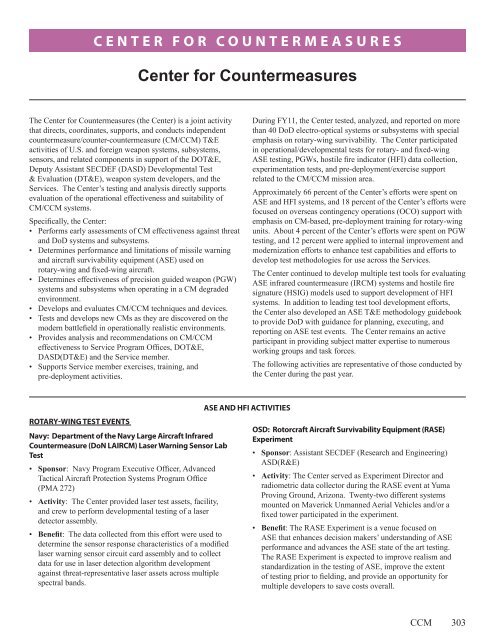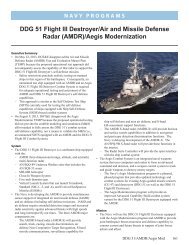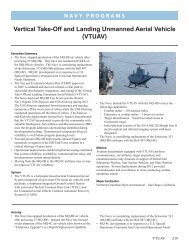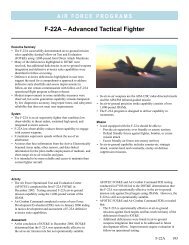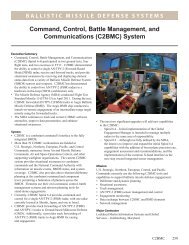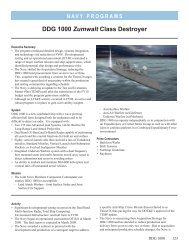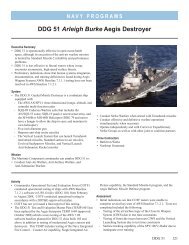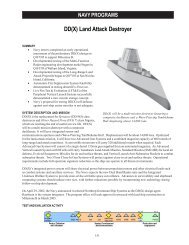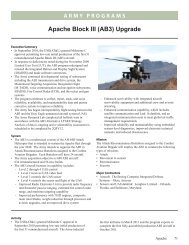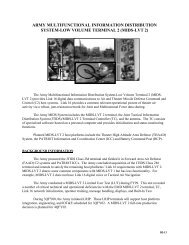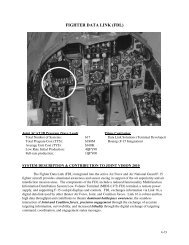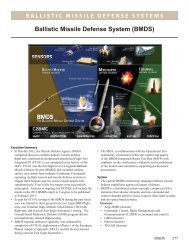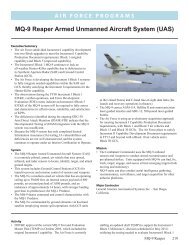Center for Countermeasures - DOT&E
Center for Countermeasures - DOT&E
Center for Countermeasures - DOT&E
Create successful ePaper yourself
Turn your PDF publications into a flip-book with our unique Google optimized e-Paper software.
center For countermeasures<br />
The <strong>Center</strong> <strong>for</strong> <strong>Countermeasures</strong> (the <strong>Center</strong>) is a joint activity<br />
that directs, coordinates, supports, and conducts independent<br />
countermeasure/counter-countermeasure (CM/CCM) T&E<br />
activities of U.S. and <strong>for</strong>eign weapon systems, subsystems,<br />
sensors, and related components in support of the DOT&E,<br />
Deputy Assistant SECDEF (DASD) Developmental Test<br />
& Evaluation (DT&E), weapon system developers, and the<br />
Services. The <strong>Center</strong>’s testing and analysis directly supports<br />
evaluation of the operational effectiveness and suitability of<br />
CM/CCM systems.<br />
Specifically, the <strong>Center</strong>:<br />
• Per<strong>for</strong>ms early assessments of CM effectiveness against threat<br />
and DoD systems and subsystems.<br />
• Determines per<strong>for</strong>mance and limitations of missile warning<br />
and aircraft survivability equipment (ASE) used on<br />
rotary-wing and fixed-wing aircraft.<br />
• Determines effectiveness of precision guided weapon (PGW)<br />
systems and subsystems when operating in a CM degraded<br />
environment.<br />
• Develops and evaluates CM/CCM techniques and devices.<br />
• Tests and develops new CMs as they are discovered on the<br />
modern battlefield in operationally realistic environments.<br />
• Provides analysis and recommendations on CM/CCM<br />
effectiveness to Service Program Offices, DOT&E,<br />
DASD(DT&E) and the Service member.<br />
• Supports Service member exercises, training, and<br />
pre-deployment activities.<br />
rotary-wIng test events<br />
navy: department of the navy large aircraft Infrared<br />
countermeasure (don laIrcm) laser warning sensor lab<br />
test<br />
• Sponsor: Navy Program Executive Officer, Advanced<br />
Tactical Aircraft Protection Systems Program Office<br />
(PMA 272)<br />
• Activity: The <strong>Center</strong> provided laser test assets, facility,<br />
and crew to per<strong>for</strong>m developmental testing of a laser<br />
detector assembly.<br />
• Benefit: The data collected from this ef<strong>for</strong>t were used to<br />
determine the sensor response characteristics of a modified<br />
laser warning sensor circuit card assembly and to collect<br />
data <strong>for</strong> use in laser detection algorithm development<br />
against threat-representative laser assets across multiple<br />
spectral bands.<br />
<strong>Center</strong> <strong>for</strong> <strong>Countermeasures</strong><br />
ase and hFI actIvItIes<br />
During FY11, the <strong>Center</strong> tested, analyzed, and reported on more<br />
than 40 DoD electro-optical systems or subsystems with special<br />
emphasis on rotary-wing survivability. The <strong>Center</strong> participated<br />
in operational/developmental tests <strong>for</strong> rotary- and fixed-wing<br />
ASE testing, PGWs, hostile fire indicator (HFI) data collection,<br />
experimentation tests, and pre-deployment/exercise support<br />
related to the CM/CCM mission area.<br />
Approximately 66 percent of the <strong>Center</strong>’s ef<strong>for</strong>ts were spent on<br />
ASE and HFI systems, and 18 percent of the <strong>Center</strong>’s ef<strong>for</strong>ts were<br />
focused on overseas contingency operations (OCO) support with<br />
emphasis on CM-based, pre-deployment training <strong>for</strong> rotary-wing<br />
units. About 4 percent of the <strong>Center</strong>’s ef<strong>for</strong>ts were spent on PGW<br />
testing, and 12 percent were applied to internal improvement and<br />
modernization ef<strong>for</strong>ts to enhance test capabilities and ef<strong>for</strong>ts to<br />
develop test methodologies <strong>for</strong> use across the Services.<br />
The <strong>Center</strong> continued to develop multiple test tools <strong>for</strong> evaluating<br />
ASE infrared countermeasure (IRCM) systems and hostile fire<br />
signature (HSIG) models used to support development of HFI<br />
systems. In addition to leading test tool development ef<strong>for</strong>ts,<br />
the <strong>Center</strong> also developed an ASE T&E methodology guidebook<br />
to provide DoD with guidance <strong>for</strong> planning, executing, and<br />
reporting on ASE test events. The <strong>Center</strong> remains an active<br />
participant in providing subject matter expertise to numerous<br />
working groups and task <strong>for</strong>ces.<br />
The following activities are representative of those conducted by<br />
the <strong>Center</strong> during the past year.<br />
osd: rotorcraft aircraft survivability equipment (rase)<br />
experiment<br />
• Sponsor: Assistant SECDEF (Research and Engineering)<br />
ASD(R&E)<br />
• Activity: The <strong>Center</strong> served as Experiment Director and<br />
radiometric data collector during the RASE event at Yuma<br />
Proving Ground, Arizona. Twenty-two different systems<br />
mounted on Maverick Unmanned Aerial Vehicles and/or a<br />
fixed tower participated in the experiment.<br />
• Benefit: The RASE Experiment is a venue focused on<br />
ASE that enhances decision makers’ understanding of ASE<br />
per<strong>for</strong>mance and advances the ASE state of the art testing.<br />
The RASE Experiment is expected to improve realism and<br />
standardization in the testing of ASE, improve the extent<br />
of testing prior to fielding, and provide an opportunity <strong>for</strong><br />
multiple developers to save costs overall.<br />
CCM 303
304 CCM<br />
center For countermeasures<br />
army: hostile Fire Indicting system (hFIs) – army Flight test 1<br />
• Sponsor: U.S. Special Operations Command (USSOCOM),<br />
Technology Applications Program Office<br />
• Activity: The <strong>Center</strong> provided the Joint Mobile IRCM Test<br />
System (JMITS) <strong>for</strong> missile simulation to support a flight data<br />
collection event with a USSOCOM MH-47 equipped with the<br />
HFIS system in Yuma Proving Ground, Arizona.<br />
• Benefit: The sponsor used this event to collect background<br />
and live fire data from the AN/AAR-57 Common Missile<br />
Warning System (CMWS), AN/AVR-2B Laser Detecting Set,<br />
Helicopter Alert Threat Termination-Acoustics, and BAE<br />
Systems acoustic detection ring <strong>for</strong> HFIS development systems<br />
installed on a representative aircraft.<br />
navy: don laIrcm gPs antenna regression test<br />
• Sponsor: Navy Program Executive Officer, Advanced Tactical<br />
Aircraft Protection Systems Program Office (PMA 272)<br />
• Activity: The <strong>Center</strong> provided test assets and crew to per<strong>for</strong>m<br />
end-to-end testing of the system to determine if the new GPS<br />
antenna integrated into the CH-46E degraded the per<strong>for</strong>mance<br />
of the DoN LAIRCM system; testing was conducted at White<br />
Sands Missile Range.<br />
• Benefit: The assessment of this threat detection and Directed<br />
Infrared <strong>Countermeasures</strong> system resulted in verification that<br />
the new GPS antenna did not degrade the per<strong>for</strong>mance of the<br />
DoN LAIRCM system.<br />
army: reduced optical signature emissions solution vI<br />
• Sponsor: Department of the Army Technology Applications<br />
Program Office, Systems Integration and Maintenance Office<br />
(SIMO) Aircraft Survivability Equipment Cell<br />
• Activity: The <strong>Center</strong> provided test assets and crew to per<strong>for</strong>m<br />
effectiveness testing of flares and flare sequences against<br />
reactive captive infrared (IR) missiles. This data was used to<br />
finalize flare sequences on 160th Special Operations Aviation<br />
Regiment rotary-wing aircraft.<br />
• Benefit: The outcome of this combined ef<strong>for</strong>t resulted in<br />
verification of the effectiveness of flare sequences used on<br />
both aircraft deployed in-theater and under development.<br />
navy/marine corps: ch-53e, mv-22, and mh-60r Flight tests<br />
• Sponsor: Naval Surface Warfare <strong>Center</strong> – Crane Division,<br />
with funding from the Aircraft Self-Protection Optimization<br />
program<br />
• Activity: The <strong>Center</strong> provided test assets and crew to per<strong>for</strong>m<br />
effectiveness testing of flares and flare sequences against<br />
reactive captive IR missiles. These tests evaluated new CM<br />
sequences, variations of current CM sequences using improved<br />
flares, or different flares within the sequences.<br />
• Benefit: The test results on flare sequence effectiveness are<br />
being used to enhance the protection of these aircraft against<br />
IR Man-Portable Air Defense Systems (MANPADS).<br />
army: Intelligent decision-aiding <strong>for</strong> aircraft survivability<br />
(Idas)<br />
• Sponsor: Department of the Army, Aviation Applied<br />
Technology Directorate<br />
• Activity: The <strong>Center</strong> provided JMITS test equipment as well<br />
as captive-carry IR missiles and crews to support end-to-end,<br />
open-air T&E of an AH-64 rotary-wing aircraft equipped with<br />
IDAS.<br />
• Benefit: The IDAS prototype testing contributed to critical<br />
future IRCM protection of Army rotary-wing aircraft.<br />
FIXed-wIng test events<br />
air Force: c-130 avionics modernization Program<br />
• Sponsor: Department of the Air Force, 418th Flight Test<br />
Squadron<br />
• Activity: The <strong>Center</strong> provided laser test assets, the JMITS,<br />
and crew to support the sponsor in their ef<strong>for</strong>t to determine the<br />
functionality of the C-130 AMP integrated defensive avionics<br />
software with the legacy defensive system.<br />
• Benefit: The data collected were used to verify the integrated<br />
system per<strong>for</strong>mance between the legacy defensive system and<br />
the new integrated defensive avionics system.<br />
air Force: laIrcm next generation Phase II c-17a<br />
developmental test (dt)/operational test (ot)<br />
• Sponsor: 654th Aeronautical Systems Squadron, Wright<br />
Patterson AFB<br />
• Activity: The <strong>Center</strong> provided missile simulation test assets<br />
and crew to per<strong>for</strong>m end-to-end testing of the LAIRCM Next<br />
Generation system installed on the C-17A operating in an<br />
open-air environment.<br />
• Benefit: This testing contributed to critical protection of Air<br />
Force heavy-lift capability during OCO operations.<br />
air Force: laIrcm next generation Phase II c-17a Iot&e<br />
• Sponsor: AFOTEC Detachment 2, Eglin AFB<br />
• Activity: The <strong>Center</strong> provided the JMITS and Towed Aerial<br />
Plume Simulator (TAPS) missile simulators and crew to<br />
per<strong>for</strong>m end-to-end testing of the LAIRCM Next Generation<br />
system installed on the C-17A operating in an open-air<br />
environment.<br />
• Benefit: This testing contributed to critical protection of Air<br />
Force heavy-lift capability during OCO operations.
center For countermeasures<br />
rotary- and FIXed-wIng test events<br />
army, osd: seeker bowl vI<br />
• Sponsors: U.S. Army Research Development<br />
and Engineering Command , and the Office of the<br />
SECDEF-Joint Electronic Advanced Technology<br />
• Activity: The <strong>Center</strong> provided test assets and crew to<br />
collect test data on flare protection effectiveness <strong>for</strong> five<br />
fixed-wing and two rotary-wing aircraft against reactive<br />
captive IR missiles. The effectiveness of new flare CM<br />
sequences or variations of current flare CM sequences<br />
were evaluated.<br />
• Benefit: Sponsors are using these test results on flare<br />
sequence effectiveness to enhance the protection of<br />
various aircraft against IR MANPADS.<br />
air Force, navy: advanced strategic and tactical Infrared<br />
expendables<br />
• Sponsors: Naval Surface Warfare <strong>Center</strong> – Crane<br />
Division; Air Force Special Operations Command; 46th<br />
Test Wing; and Air Mobility Command<br />
• Activity: The <strong>Center</strong> provided test assets and crew to<br />
collect test data on eight different aircraft against reactive<br />
captive IR missiles. These tests evaluated new flare CM<br />
sequences, variations of current flare CM sequences<br />
using improved flares, or different flares within the<br />
sequences.<br />
• Benefit: Sponsors are using these test results on flare<br />
sequence effectiveness to enhance the protection of<br />
various aircraft against IR MANPADS.<br />
hostIle FIre IndIcator (hFI) data collectIon events<br />
navy: aar-47 hFI upgrade and multi-Function threat detector<br />
live-Fire data collection<br />
• Sponsor: Navy Program Executive Officer, Advanced Tactical<br />
Aircraft Protection Systems Program Office (PMA-272)<br />
• Activity: The <strong>Center</strong> provided radiometric instruments and crew<br />
during the testing of the AAR-47 and Multi-function Threat<br />
Detector at China Lake Naval Weapons Test <strong>Center</strong>, Cali<strong>for</strong>nia.<br />
• Benefit: This activity provided a venue <strong>for</strong> testing of HFI systems<br />
<strong>for</strong> rapid fielding deployment and collected threat signature data<br />
<strong>for</strong> use in developing hostile fire models.<br />
army: hostile Fire detection system signature ammo study (sas)<br />
• Sponsor: Program Manager-Aircraft Survivability Equipment<br />
(PM–ASE)<br />
• Activity: The <strong>Center</strong> provided radiometric equipment and<br />
test crews to collect and reduce signature data on small arms<br />
(muzzle, hardbody and tracer) and rockets (eject, boost, and tracer<br />
characteristics) on three separate test events: SAS-1, SAS-2, and<br />
SAS-W.<br />
• Benefit: The measured data results will determine the variability<br />
within ammunition types and country of origin. The measured<br />
data will be used to develop the DOT&E Threat Resource Activity<br />
(TETRA)-sponsored hostile fire signature (HSIG) model. The<br />
<strong>Center</strong> will develop the HSIG model that will integrate into T&E<br />
Modeling and Simulation facilities and support Hostile Fire<br />
Detection System <strong>for</strong>eign ammunition purchases to support test<br />
events.<br />
Pgw cm actIvItIes<br />
army: 66 mm red Phosphorous grenade Ir characterization<br />
• Sponsors: U.S. Army Joint Attack Munition System Project Office, Joint Air-to-Ground Missile (JAGM) Program Office and U.S.<br />
Army Edgewood Chemical Biological <strong>Center</strong><br />
• Activity: The <strong>Center</strong> planned, coordinated, and executed a field test to characterize the 66 mm vehicle launched, self-screening<br />
grenade. The characterization consisted of various physical property and IR measurements, including the ability to conceal a target.<br />
• Benefit: The characterization of the 66 mm red phosphorus grenades will provide data to support the selection of suitable battlefield<br />
obscurants <strong>for</strong> use during DT ef<strong>for</strong>ts to reach acquisition milestone C <strong>for</strong> the JAGM program.<br />
cm-based Pre-dePloyment traInIng For rotary-wIng unIts<br />
mission employment exercise – Nellis AFB, Nevada enhanced mohave viper – Twentynine Palms, Cali<strong>for</strong>nia<br />
hh-60 surface attack training – Nellis AFB, Nevada emerald warrior – Eglin AFB, Florida<br />
combat search and rescue joint Integration exercise – Nellis, AFB, Nevada<br />
• Sponsors: Various<br />
• Purpose: The <strong>Center</strong>’s equipment and personnel provided a simulated threat/CM environment and subject matter expertise<br />
to observe aircraft sensor/ASE systems and crew reactions to this environment. Emphasis was placed on providing simulated<br />
MANPAD engagements <strong>for</strong> participating aircraft.<br />
• Benefit: Provides realism to the training threat environment <strong>for</strong> the pilots and crews to facilitate understanding and use of CM<br />
equipment, especially ASE. Data collected are provided to the trainers <strong>for</strong> assisting units in the development/refinement of tactics,<br />
techniques, and procedures to enhance survivability.<br />
CCM 305
hsIg model<br />
306 CCM<br />
center For countermeasures<br />
The <strong>Center</strong> is leading development of an HSIG model to support<br />
HFI T&E and modeling ef<strong>for</strong>ts. The HSIG Model project is<br />
sponsored by the TETRA and will develop a physic-based,<br />
electro-optical model that produces signatures <strong>for</strong> the 12.7 mm<br />
Armor Piercing Incendiary Tracer round and rocket-propelled<br />
grenade. After initial development and validation, the HSIG<br />
model will be expanded to include more hostile fire threats.<br />
annual hostile Fire Indicator conference<br />
The <strong>Center</strong> held an HFI symposium and workshops that included<br />
current HFI program briefings, “break-out” coordination sessions,<br />
and DoD and international partner in<strong>for</strong>mation exchange.<br />
This <strong>Center</strong>-led initiative provides a venue <strong>for</strong> cross-Service<br />
discussion on the common problem of Service member protection<br />
from hostile fire in theater.<br />
joint countermeasures t&e working group (jcmt&e wg)<br />
The JCMT&E WG is co-chartered by DOT&E and<br />
DASD(DT&E) to improve the integration of aircraft selfprotection<br />
developmental, live-fire and operational T&E through<br />
standardized test methodologies, instrumentation and standards.<br />
This group includes DOT&E, DASD(DT&E), all four of the U.S.<br />
Services, Australia, Canada, New Zealand, United Kingdom and<br />
NATO Air Force Armaments Group Sub-Group 2, as members of<br />
a coalition warfare sub-WG. The group is tasked with actively<br />
seeking mutually beneficial T&E opportunities to measure valid<br />
per<strong>for</strong>mance and suitability data necessary to provide relevant<br />
operational in<strong>for</strong>mation to deploying Joint/Coalition Warfighters<br />
and <strong>for</strong> U.S. acquisition decision makers. Specific ef<strong>for</strong>ts include<br />
the following:<br />
• The <strong>Center</strong> was instrumental in developing, coordinating<br />
and implementing an eight-year bilateral Cooperative Test<br />
and Evaluation ASE Project Arrangement with the United<br />
Kingdom. Both nation’s defense organizations, ASE program<br />
offices, DT, OT and LFT&E agencies, will now be able<br />
to collaborate on common test equipment and procedures,<br />
measure operationally relevant ASE data, and improve Service<br />
member survivability.<br />
The <strong>Center</strong>, in conjunction with the Test Resource Management<br />
<strong>Center</strong>, is leading the IRCM Test Resource Requirements Study<br />
(ITRRS) “refresh.” The end product from this ef<strong>for</strong>t will be an<br />
updated roadmap of prioritized projects necessary to per<strong>for</strong>m<br />
T&E of advanced IRCM and HFI systems. The original ITRRS<br />
roadmap was completed in 2007, which led to several projects<br />
being funded by Central Test and Evaluation Investment Program<br />
to fill the identified IRCM T&E gaps. Each product will have<br />
a functional description of the project; the priority is based<br />
upon Program of Record need dates, test requirements, and<br />
Service input.<br />
survIvabIlIty InItIatIves<br />
threat sImulator test and evaluatIon tools<br />
• The JCMT&E WG has scheduled official negotiations with<br />
Australia on a bilateral ASE Project Arrangement to expand<br />
our T&E capabilities and cooperation.<br />
• In support of <strong>for</strong>mer SECDEF, HON. Robert Gates, and<br />
NATO Secretary General, HON. Anders Fogh Rasmussen’s<br />
High-Level NATO Multinational Approaches Initiatives,<br />
the <strong>Center</strong> developed and delivered Dr. Gilmore’s DOT&E<br />
initiatives to NATO and is now leading an exploratory<br />
technical team to develop alliance-wide solutions.<br />
• The <strong>Center</strong> is collaborating with DOT&E’s TETRA in defining<br />
ASE/HFI data needs <strong>for</strong> a NATO accessed, interactive web<br />
page, and establishing a centralized location <strong>for</strong> the Coalition’s<br />
HFI data that will be accessible by Service members and U.S.<br />
Service program managers.<br />
helicopter survivability task Force (hstF)<br />
The <strong>Center</strong> participated in the Assistant SECDEF <strong>for</strong> Research<br />
and Engineering-led HSTF discussions that examined helicopter<br />
survivability <strong>for</strong> DoD project selection (out-of-cycle funding<br />
request to Congress and the Future Years Defense Program in<br />
FY11). The <strong>Center</strong>’s three recommended projects were ranked in<br />
the top four by the Services.<br />
aircraft survivability equipment test and evaluation<br />
methodology guidebook<br />
DOT&E tasked the <strong>Center</strong> to create an ASE T&E Methodology<br />
Guidebook to provide the DoD with guidance <strong>for</strong> planning,<br />
executing, and reporting on ASE systems’ test events. The ASE<br />
systems addressed in this guidebook include IRCM, UV and<br />
IR passive Missile Warning Systems (MWS), HFI, and Laser<br />
Warning Receiver systems.<br />
The guidebook is intended to provide program managers, T&E<br />
leads, test directors, and test team members with a process <strong>for</strong><br />
ASE system testing. Such a guide is especially critical <strong>for</strong><br />
program managers and test managers/leads new to ASE testing.<br />
This guidebook provides suggested processes and procedures<br />
<strong>for</strong> collecting test data, as well as suggested data <strong>for</strong>mats and<br />
products <strong>for</strong> presenting test data to aid the T&E community in<br />
achieving consistency and expectations.<br />
The <strong>Center</strong> has continued to develop tools <strong>for</strong> test and evaluation<br />
of IRCM systems funded by the USD(AT&L) Test Resource<br />
Management <strong>Center</strong>, Central Test and Evaluation Investment<br />
Program. Currently, the <strong>Center</strong> is leading the development of the<br />
following test tools:<br />
• The TAPS is used to resolve shortfalls of emulating spatial/<br />
temporal signatures <strong>for</strong> testing MWS and IRCM systems. This<br />
tool has the ability to test aircraft at various airspeeds, cover<br />
a greater portion of the operational battle space, and test in<br />
a realistic IR clutter environment. TAPS development was
center For countermeasures<br />
completed in FY11 and supported the operational testing of<br />
LAIRCM Next Generation.<br />
• The Multi-Spectral Sea and Land Test Simulator is a small,<br />
mobile missile simulator that can fire while moving and<br />
simulate all current tier-one missile threats. It is designed<br />
to provide simulated signatures <strong>for</strong> the new and more<br />
capable missile warning systems, such as LAIRCM Next<br />
Generation, DoN LAIRCM, and Joint and Allied Threat<br />
Awareness System.<br />
• The <strong>Center</strong> is developing the functional requirements <strong>for</strong> the<br />
Joint Standard Instrumentation Suite (JSIS). The JSIS is to be<br />
a comprehensive, turn-key instrumentation package that can be<br />
used during hostile fire testing and MANPADS missile firing<br />
events to support model development and validation. The<br />
JSIS will provide calibrated signature measurements <strong>for</strong> T&E<br />
(enhanced test adequacy), and post-test anomaly resolution. All<br />
data collected using JSIS will be archived and made available to<br />
the Services <strong>for</strong> current and future IRCM programs.<br />
CCM 307
308<br />
center For countermeasures


